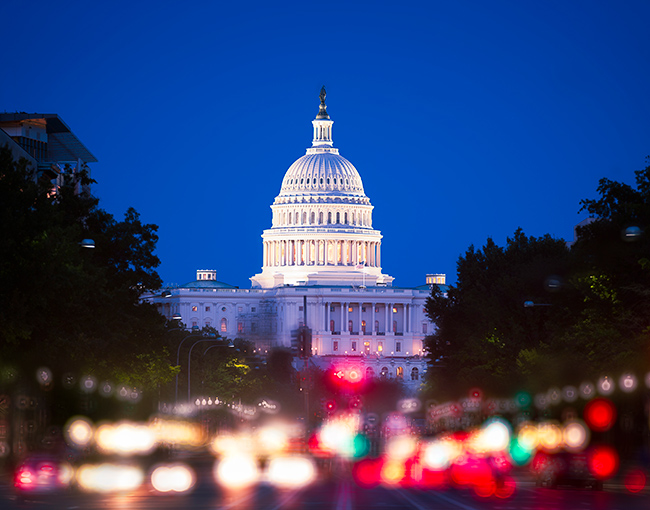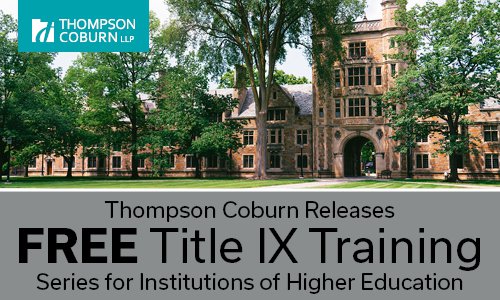Yesterday, the U.S. Department of Education issued significant new guidance to institutions of higher education regarding their receipt and use of the funds being distributed through the Higher Education Emergency Relief Fund (HEERF), a relief program created by the Coronavirus Aid, Relief, and Economic Security (CARES) Act. Thompson Coburn is closely monitoring those elements of the CARES Act that provide direct and indirect relief to institutions of higher education. Below, we review the important, and in some cases, surprising information that was included in the new guidance documents. Institutions with questions regarding the CARES Act or the Department’s guidance are welcome to contact any of the individuals noted at the end of this post. We also encourage you to monitor REGucation, our higher education blog, and to watch for our webinars on the topic.
First tranche funds (student emergency grants)
The Department released a new Frequently Asked Questions document concerning the distribution of the first tranche of relief funds, which must be used for emergency financial aid grants to students. This new document included the following direction from the agency:
- Use of funds. Emergency financial aid grants may be provided “using checks, electronic transfer payments, debit cards, and payment apps that adhere to the Department’s requirements for paying credit balances to students.” Funds must be unencumbered by the institution, meaning “debts, charges, fees, or other amounts owed to the institution may not be deducted from the emergency financial aid grant.” Indeed, and as expected, the Department emphasized that emergency financial aid grants to students must be provided to students. The agency made clear that institutions may not use emergency financial aid grants to:
- Reimburse themselves for refunds provided to students, including for room and board, tuition, and other fees (such as activities fees);
- Reimburse themselves for the provision of information technology hardware (such as laptops, hotspot internet devices, etc.) or related equipment;
- Reimburse themselves for payments made to student workers; or
- Satisfy a student’s outstanding or overdue student bill or account balance.
- Reimburse themselves for refunds provided to students, including for room and board, tuition, and other fees (such as activities fees);
- Student eligibility. To the surprise of many, the Department indicated that only students who are or could be eligible to participate in programs under Section 484 in Title IV of the Higher Education Act of 1965, as amended, may receive emergency financial aid grants. Students are not required to have applied for or received Title IV funds, but they must be eligible to do so. This means that undocumented and most nonimmigrant students are not eligible to receive emergency grant funds. Also to the surprise of many, the Department took the position that students enrolled in exclusively online programs on March 13, 2020, are not eligible for emergency financial aid grants, on the basis that they “would not have expenses related to the disruption of campus operations due to coronavirus.” Finally, for incarcerated students participating in the Second Chance Pell Experimental Site Initiative, institutions will need to review on a case-by-case basis what expenses, if any, an incarcerated person or formerly incarcerated person released due to coronavirus has incurred due to the disruption of campus operations.
- 90/10 calculation. Funds paid directly to institutions by the Department through the HEERF will not be included as revenue for 90/10 purposes.
- Reporting obligations. The Department confirmed that institutions are required to report “how grants were distributed to students, how the amount of each grant was calculated, and any instructions or directions that the institution gave to students about the grant” as well as comply with the reporting requirements in Section 15011 of the CARES Act. Further instructions are forthcoming in a notice in the Federal Register.
Second tranche funds (institutional costs)
The Department also released new guidance documents concerning the second tranche of relief funds, which, per Section 18004(c) of the CARES Act, must be used “to cover any costs associated with significant changes to the delivery of instruction due to the coronavirus, so long as such costs do not include payment to contractors for the provision of pre-enrollment recruitment activities; endowments; or capital outlays associated with facilities related to athletics, sectarian instruction, or religious worship.” Specifically, the agency made the following documents available:
- A new letter from the Secretary, dated April 21, 2020, describing the timing of the distribution and the purpose of the second tranche funds.
- A new Funding Certification and Agreement that institutions must complete and upload to secure second tranche funds.
- A new Frequently Asked Questions document concerning the distribution of second tranche funds.
- An allocation table detailing the amount of second tranche funds released to each institution, as well as additional technical guidance for uploading documentation to a “workspace” on grants.gov.
The Department offered insight regarding the distribution and use of second tranche funds. Below, we highlight salient points pulled from the Secretary’s Letter, the new Funding Certification and Agreement, and the Frequently Asked Questions document.
- Institutional eligibility and application. An institution must sign the new Funding Certification and Agreement for the second tranche funds and submit the agreement through grants.gov. To be eligible, an institution must have agreed to receive and distribute the first tranche of relief funds for student emergency grants. The Department observed that any authorized representative can sign the Funding Certification and Agreement, while noting that this typically would be a “president, chancellor, or Chief Executive Officer (CEO), or their delegated representative.” And this time, the agency has provided the necessary funding opportunity number (ED-GRANTS-042120-004).
- Use of funds. In her letter, the Secretary encourages institutions to use second tranche funds to increase support for students most in need, “expand [] remote learning programs, build [] IT capacity to support such programs, and train faculty and staff to operate effectively in a remote learning environment.” In the new Funding and Certification Agreement, the Secretary “urges” institutions “to devote the maximum amount of funds possible to emergency financial aid grants to students, including some or all of the funds earmarked for Recipient’s Institutional Costs, especially if Recipient has significant endowment or other resources at its disposal.” This having been said, the Agreement then acknowledges that each institution “retains discretion in determining how to allocate and use the funds provided hereunder, provided that funds will be spent only on those costs for which Recipient has a reasoned basis for concluding such costs have a clear nexus to significant changes to the delivery of instruction due to the coronavirus.”
The FAQ document indicates that an institution may use second tranche funds for a range of purposes, including:
- To provide refunds to students, or to reimburse itself for refunds made to students on or after March 13, 2020, “for room and board, tuition, and other fees” so long as those refunds were required because of “significant changes to the delivery of instruction, including interruptions in instruction, due to the coronavirus.” We highlight that Section 18004(c) of the CARES Act provides only that relief funds may be used to cover “costs associated with significant changes to the delivery of instruction due to the coronavirus.” In its FAQ document, the Department expands on this concept, including refunds necessitated by “interruptions in instruction” caused by the coronavirus. This is an important addition, as it opens the door to covering institutional refunds that resulted from campus interruptions, despite being unrelated to a change in instructional delivery. We also emphasize that this is the only place in the guidance where this addition appears.
- To cover costs incurred to “purchase equipment or software, pay for online licensing fees, or pay for internet service to enable students to transition to distance learning” so long as such costs are “associated with a significant change in the delivery of instruction due to the coronavirus.” An institution also can reimburse itself for the cost of computers or other equipment provided to students long as the costs were incurred on or after March 13, 2020.
- To make additional emergency financial aid grants to students, so long as the grants are made to eligible students to cover qualified expenses, consistent with the guidance governing the distribution of first tranche funds.
- To fund scholarships or to provide payment for future academic terms, so long as these scholarships or payments qualify as “costs associated with significant changes to the delivery of instruction due to the coronavirus.” The Department’s guidance implied that this may be a difficult standard to meet. We agree and suggest that institutions contemplating this option proceed with caution.
- To pay “a per-student fee to a third-party service provider, including an OPM, for each additional student using the distance learning platform, learning management system, online resources, or other support services; however, institutions may not use [second tranche funds] to pay third-party recruiters or OPMs for recruiting or enrolling new students at the institution.”
- To provide refunds to students, or to reimburse itself for refunds made to students on or after March 13, 2020, “for room and board, tuition, and other fees” so long as those refunds were required because of “significant changes to the delivery of instruction, including interruptions in instruction, due to the coronavirus.” We highlight that Section 18004(c) of the CARES Act provides only that relief funds may be used to cover “costs associated with significant changes to the delivery of instruction due to the coronavirus.” In its FAQ document, the Department expands on this concept, including refunds necessitated by “interruptions in instruction” caused by the coronavirus. This is an important addition, as it opens the door to covering institutional refunds that resulted from campus interruptions, despite being unrelated to a change in instructional delivery. We also emphasize that this is the only place in the guidance where this addition appears.
- Reporting obligations. The Department observed that institutions should be “prepared to report the use of the funds,” and to describe “any internal controls [the institution] has in place to ensure that funds were used for allowable purposes and in accordance with cash management principles.” The agency also encouraged institutions “to keep detailed records of how they are expending all funds received under the HEERF,” and again indicated that “[f]urther instructions are forthcoming in a notice in the Federal Register.”
Aaron Lacey is the leader of Thompson Coburn’s Higher Education practice, host of the Firm’s popular Higher Education Webinar Series, and editorial director of REGucation, the Firm’s higher education law and policy blog. Chris Murray is the co-chair of Thompson Coburn’s Lobbying & Policy practice group, and has been recognized for the depth of his knowledge of education policy, which spans all corners of education, from pre-K through primary, secondary, and postsecondary, from institutions and trade associations to technology companies and investors. Katie Wendel, a member of the Firm’s Higher Education Practice, represents higher education clients in a wide range of regulatory and transactional matters. Scott Goldschmidt is the former Deputy General Counsel for a prominent institution of higher education, and a member of the firm’s Higher Education practice.
Click here to subscribe to News & Insights from Thompson Coburn related to our practices as well as the latest on COVID-19 issues.














